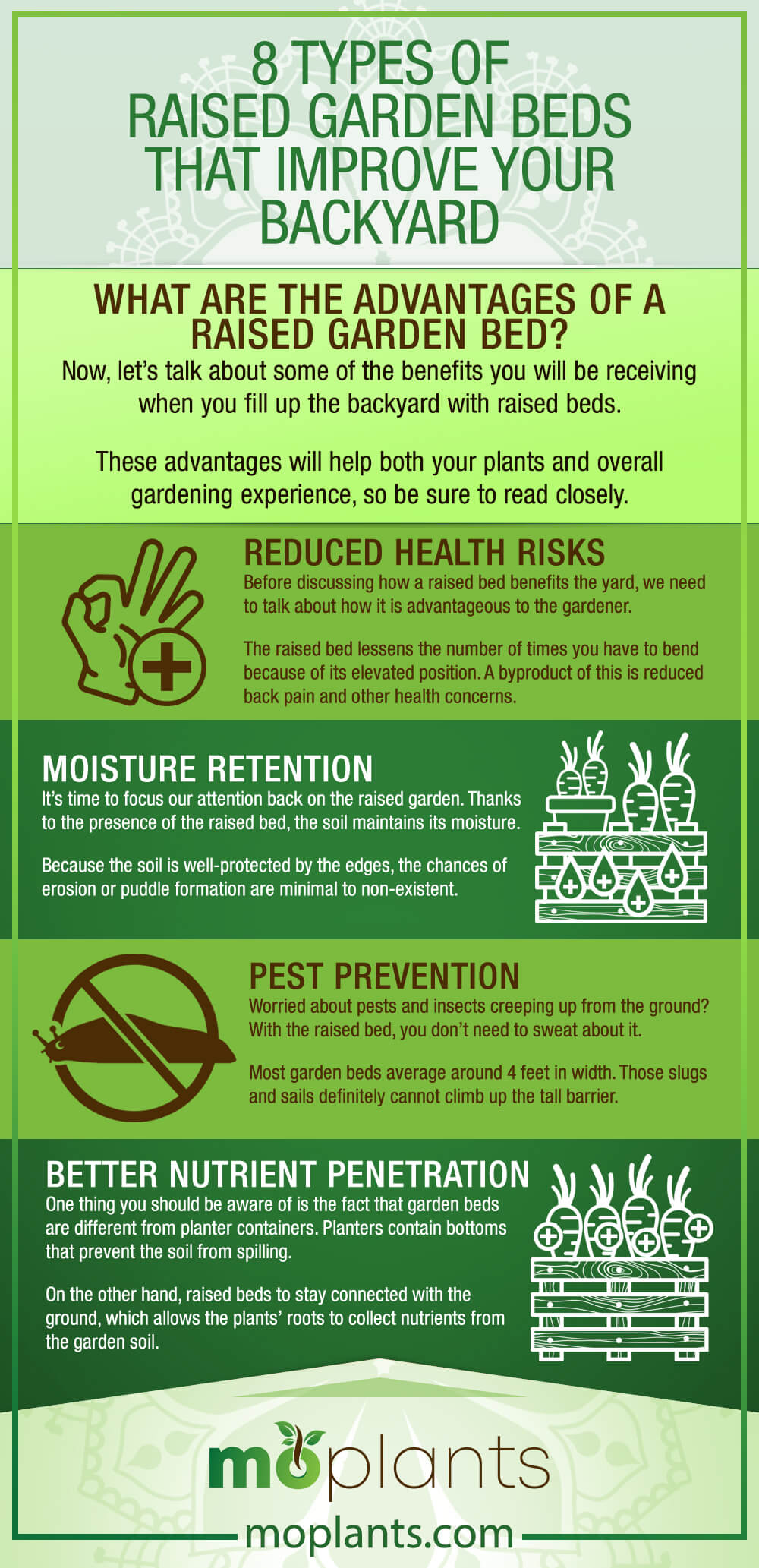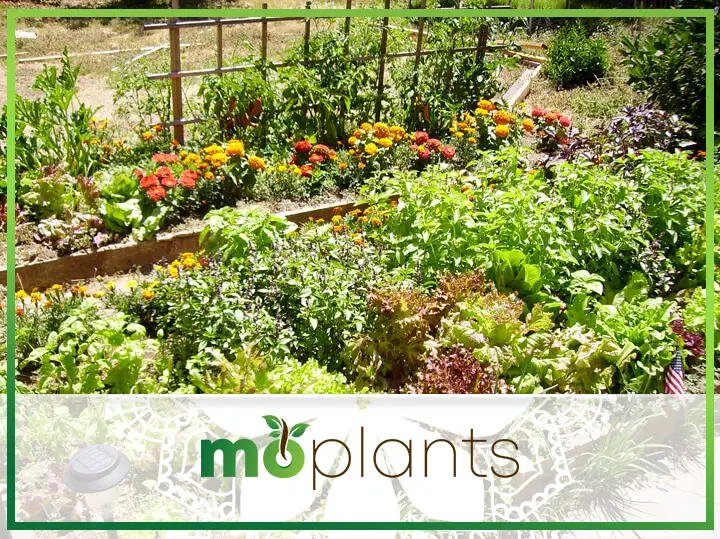Raised garden beds have become popular among gardeners and homeowners. They offer creativity, practicality, and aesthetic appeal.
“So which types of raised garden beds should I consider for my backyard?” you may ask.
Don’t worry. We will guide you in choosing based on your needs and preferences.
Built-In Raised Beds
Do you want to stick to basics and avoid any complications? Why not try out the built-in raised bed garden?
It does not get in the way of the backyard because you can fit it in spots that have either great sun or shade exposure.
Unlike ground gardens, the built-in raised bed enables better soil quality and water drainage. These are essential for the development of nutrients for the soil, vegetables, and plants.
If the sides are wide enough, you can sit on it if you need to do some soul searching.
Square Birth Raised Beds
If you have a knack for organizing your plants into different sectors and groups, the square birth raised bed should be the go-to option.
Usually, these work if you plan on creating a kitchen garden, edible garden, and vegetable garden.
The 1-foot squares may only offer small spaces, but the plants get enough air ventilation and nutrients thanks to the equal spacing each square provides.
As a result, the square birth raised bed improves soil quality and water drainage. [R]
Hoop House Raised Beds
Do you want a raised bed that gives you versatility throughout the seasons? If yes, then hoop house is your best bet.
The multi-seasoned vegetables and plants can resist extreme weather and combat frost.
The beds’ diverse array of veggies and edible plants make it difficult for most pests and animals to penetrate the herb garden.
Raised Bed Border
Are you living in an area with steep slopes? If yes, then it’s time to unleash your inner imagination skills by creating an illusion of an equal level flower garden.
You can do so by assembling stone raised garden beds. Widening your ground beds’ layout is a great way to provide ample space for your colorful flowers and plants.
The large and even space distribution allows each plant to receive nutrients during the growing season.
Trough Gardens
Continuing the trend of unique raised bed gardens is the trough gardens.
While other bed gardens use conventional materials like rot-resistant wood, concrete, and cinder block, trough gardens operate with metal.
You may need to create small spaces by drilling the beds with holes so that the soil can enter. Unlike wood, metal conducts heat, which results in warm soil during springtime.
However, the full effects of the sun will be felt during the summer season. Therefore, you need to supply your plants with H20 during the warmest months of the year.
Trellis or Arbor
Some, if not most, ground beds and edible plants apply horizontal gardening. However, what if I told you a vertical garden exists?
You heard that right. The trellis and arbor is an alternative you can use if you want your flower garden to look more presentable.
Vertical gardening prevents plants from clumping together because it requires less space. This kind of raised bed setup gives your plants better ventilation and equal sunlight exposure.
Colorful Concrete Raised Garden Beds
Everyone loves a colorful backyard. Many are also huge fans of recycling materials. With the colorful concrete raised garden beds, you get to achieve both.
Applying multiple colors to your garden beds is a great idea for personalizing the backyard. All you have to do is spray these with paint, and you’re good to go.
Unlike cinder blocks, concrete materials avoid the emergence of ash. However, the material is notorious for leeching lime, a harmful component to the soil’s pH level.
To be safe, use alkaline soil to maintain consistency and reduce chemical reactions.
Multi-Tiered Raised Bed
Are you still feeling the Christmas mood? If you want to maintain the holiday cheer for the whole year, try out multi-tiered raised beds.
It applies a vertical gardening format similar to the trellis, so expect sufficient air ventilation for your plants. Equal access to air results in enough nutrients and moisture for each plant.
You can place stockings, greens, and lights during the holidays to invite a festive mood and Christmas vibe to the home.
What Is a Raised Garden Bed?
Simply put, a raised garden bed is placed on top of the soil, meaning the plants go above the ground.
With the help of different building materials, raised beds can range from a couple of inches to waist-high length.
As far as the garden layout is concerned, each raised bed provides equal space distribution.
It allows you to walk around the garden without stepping on the raised beds. Adequate space also enables the soil to stay soft, thus preventing soil compaction.
In terms of construction, frames should surround the bed garden for enhanced protection. You get to decide what material you want to use for the frame construction.
Most raised beds are made out of wood, concrete blocks, bricks, you name it.
What Are the Advantages of a Raised Garden Bed?
Now, let’s talk about some of the benefits you will be receiving when you fill up the backyard with raised beds.
These advantages will help both your plants and overall gardening experience, so be sure to read closely.
Reduced Health Risks
Before discussing how a raised bed benefits the yard, we need to talk about how it is advantageous to the gardener.
The raised bed lessens the number of times you have to bend because of its elevated position. A byproduct of this is reduced back pain and other health concerns.
Therefore, you won’t have to spend extra on painkillers or massages.
Also, investing in rot-resistant wood raised beds reduces structural damage, avoiding any health repercussions.
Moisture Retention
It’s time to focus our attention back on the raised garden. Thanks to the presence of the raised bed, the soil maintains its moisture.
Because the soil is well-protected by the edges, the chances of erosion or puddle formation are minimal to non-existent.
Pest Prevention
Worried about pests and insects creeping up from the ground? With the raised bed, you don’t need to sweat about it.
Most garden beds average around 4 feet in width. Those slugs and sails definitely cannot climb up the tall barrier.
Better Nutrient Penetration
One thing you should be aware of is the fact that garden beds are different from planter containers. Planters contain bottoms that prevent the soil from spilling.
On the other hand, raised beds to stay connected with the ground, which allows the plants’ roots to collect nutrients from the garden soil.
Infographic

What Should You Consider When Constructing a Raised Garden Bed?
Setting up your very own raised garden bed is not as easy as it looks. Ir requires a lot of patience, hard work, persistence, and accuracy.
You may even need help from other neighbors and gardening experts to assemble the raised beds. That being said, here are some major things to consider when you start setting up the raised bed.
Frame Material
The material type will matter a lot when you begin the assembly process.
It will determine whether or not the raised beds can withstand external factors like pests, droughts, typhoons, and other natural calamities.
Although you still have the final say, we suggest you go for materials like stone, wood, and woven willow for the best results.
Also, try to stay away from fly ash to avoid toxic components from entering gardens. These, along with other user-friendly materials, are rot-resistant and food-safe.
Yard Size
Another important factor to take note of is the space limitations of your garden.
Not all gardens have the same dimensions. For example, one garden may have a sloping yard compared to the rest.
The yard size determines the bed’s length, while your ability to reach the center of the bed gauges the width.
If you are looking for the average dimensions, most gardens go for beds with a length of 6-12 inches and a width of up to 4 feet.
You want to make sure you can walk around the garden without stepping on the beds. Doing so might compact the soil and alter nutrient collection.
Convenience
Last but not least, you want to give yourself an easy time inserting the raised beds all across your garden.
While the DIY raised garden beds may be a good idea if you are running on a tight budget, buying all the parts on your own can be a hassle.
One advantage garden bed kits have over their DIY counterparts is you have everything you need, from the materials to the exact dimensions.
With the garden bed kits, expect your raised beds to stand up and stand out in just minutes.
Conclusion
I hope you enjoyed going over the different types of raised beds you can use for your vegetable garden.
May the pointers we discussed convince you to give you a head start in upgrading your yard. Have fun showcasing your gardening skills.
For more questions, inquiries, or concerns, please feel free to contact us.

